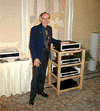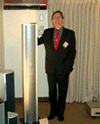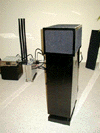Event – Sin City: Part Two
| Event – Sin City: Part Two |
| Surveying CES |
| Jason Serinus and Clement Perry |
| 20 March 2000 |
“…the smaller listening room, featuring new, not-yet-available PS Audio power cords, cables and electronics, and Power Plants on all equipment, hooked up to the big Revel speakers, delivered such a stunning, solid, color-filled, three-dimensional rendition of the first minutes of Mahler’s Symphony No. 6 and the aforementioned Archduke Trio that I decided on the spot that those speakers, a few PS Audio P600 Power Plants, and the ability to pay a large electric bill could give me all the apartment listening pleasure I would ever want. “
This year marked my first visit to the Las Vegas Consumer Electronics Show. While I have attended at least three Stereophile Shows as a consumer and audiophile society member, I found a “show” mainly geared to industry professionals. Quite a different eye- and ear-opening experience.
Besides briefly visiting the huge Home Theater set-up in the main convention center, I confined my time to the high-end exhibits at the Alexis Park and its next-door neighbor, the St. Tropez. A lot of my first day was spent saying hello to manufacturers and others I knew; the other days were spent listening to as much music as possible. My personal quest involved speakers and speaker cable I might afford; the notion of reviewing equipment, however, was always with me.
The first thing that struck me was the vast difference between the “aimed for” sound of different rooms. I distinguish “aimed for” sound from actual sound, since it is often difficult for manufacturers to achieve the sound they actually wished to create in quickly set up hotel rooms. Room considerations aside, because my favorite classical CD tracks sounded vastly different from room to room, I was frequently able to get a sense of what manufacturers were striving for.
At one extreme, I would lump the atmospheric/warm/soft set-ups. There was no concern about hard treble or hernia-inducing bass in these rooms. Everything was air, air, and air. The most representative of these was the E.A.R, room, which, at the time I visited, conveyed a diffuse, infinitely atmospheric sound-picture that lacked both driving impact and any semblance of a cutting edge on highs. (Very different from my at-home audition of the E.A.R. tubed line stage preamp). I can see how people would find this sound appealing – it certainly did not threaten my eardrums, which are pretty sensitive (I had to take a day off from my lastStereophile Show to allow the ear fatigue and pain to subside)—but it in no way resembled what I frequently hear in the front, middle and rear of various unamplified classical music settings.
At the other end of the spectrum were the bright, hard-sounding rooms whose systems seemed to beg for something like the PS Audio Power Plant or different speaker cable (or, frankly, equipment makeovers) to render images more rounded, three-dimensional, separated and life-like. The very shiny Evett & Shaw speaker/NAD combination was so offensive on the classical vocals I played that even the man running the room took one look at me and said “This is too bright, isn’t it?” (Covering all the ways with shiny printed display sure didn’t help).
In between lay a host of rooms where sound began to approach something, I would consider realistic. My favorite of these was the PS Audio two-room set-up so filled with people wheeling and dealing that I was only able to snatch a few listenable minutes over two occasions. Nonetheless, the smaller listening room, featuring new, not-yet-available PS Audio power cords cables and electronics, and Power Plants on all equipment, hooked up to the big Revel speakers, delivered such a stunning, solid, color-filled, three-dimensional rendition of the first minutes of Mahler’s Symphony No. 6 and the aforementioned Archduke Trio that I decided on the spot that those speakers, a few PS Audio P600 Power Plants, and the ability to pay a large electric bill could give me all the apartment listening pleasure I would ever want.
Single-ended triode electronics continued to frustrate me. Many rooms had the most costly and perhaps best – certainly better than anything I’ve heard in the four disappointing Audio Note demos I’ve attended– the Lamm Industries M1.2 monoblocks ($29,200/pair). These were frequently paired with either Wadia CD or Sony DSD units. While the bass and midrange were mightily inviting and impressive, I still found the top soft. But it depended upon what music was played. In one room, I heard the Lamms paired with the Nearfield Acoustics Pipedreams (a very big item at the show). The person in the sweet spot before me was playing a Dead Can Dance track. It sounded great. But then, when I put on my Mahler, the realism of violin sound that I hear even in the far Second Tier of San Francisco’s Davies Symphony Hall was nowhere in evidence. (Translation: electronically-enhanced, studio-recorded pop music was made warm and inviting, while music that sounded more natural to begin with lost its cutting edge). The very gracious Pipedreams man then sent me to their other room in the other hotel, whose 5,000,000 watt Plinius solid-state monoblocks he thought would be far more to my taste. It was a much smaller room, very cramped, and in short order filled to over-capacity with listeners and the usual people in the corner talking over the music because they were far more interested in carrying equipment that had garnered hot reviews than ever bothering to listen to it. In this Florida-temperature space, alas, full-range orchestral music could not be played at realistic levels without become much too bright and distorted in the bigger passages. Those amps were definitely overkill for the space.
“I visited Bay Area magician Jack Bybee’s room, and heard a very convincing demonstration of his devices as played through dcs Elgar 24/192 electronics. (I tried three times to win a pair of his daily raffle interconnect raffle, but the God of High End deemed me unworthy of such an honor.”
Sony had a very controlled DSD demo, one that required advance tickets and waiting in line. Robert Harley, with whom I have always had fine interactions, ended up sitting next to me. What seemed like half of the twenty minutes allowed us was taken up by a very “um”ing spokesperson, telling us nothing that hasn’t already been said countless times about DSD. What music I did hear, which included a chorus recorded in a chapel and a surround sound cut from a not-yet-released Joni Mitchell album, sounded very good, but in no way convinced me that I was hearing the closest reproduction to live that might be possible to achieve. But then again, when you choose to show off your technology with a 48-track studio recording that softens the cigarette-edge of Joni Mitchell, and drowns the very moving and pathos-filled sound of her still-beautiful voice in soupy violins, and conduct the demo in a room whose dimensions in no way approximate the dimensions of a decent listening or performing space, what can you expect?
Great guy reviewers Barry Willis and Paul Knutson both directed me to Alan Yun’s Silverline speakers, which sounded mighty impressive for the size and price. Nonetheless, show conditions did not allow me the space and silence required for accurate evaluation. (Apologies to Alan for trying to shut people up). I visited Bay Area magician Jack Bybee’s room, and heard a very convincing demonstration of his devices as played through dcs Elgar 24/192 electronics. (I tried three times to win a pair of his daily raffle interconnect raffle, but the God of the High End deemed me unworthy of such an honor. I think I should be given one of those Elgars in consolation). I was very eager to hear the Peter Madnick-designed P.1A from Perpetual Technologies, but the small Martin Logans their jerry-rigged P.1A (not finished at show time) was playing through was better at convincingly showing before and after speaker correction (fab) than delivering satisfying-to-Serinus sound. (Mark Schifter will demo the P.1A in San Francisco at a Bay Area Audiophile Society meeting on April 22 – contact me at healrmn@planeteria.net for information). And, despite hooking up single-ended electronics to those two-horned Uno or whatever they are speakers that leave me horny for realistic sound, the generous Stephen Creamer’s superb Nirvana cable sounded its usual wonderful self. Promising were the larger, great-looking Merlins, which clearly sound best when their bass module was battery-powered. (I learned this because the batteries lost their charge midway in the demo, forcing designer Bobby Palkovic to switch to electricity). The bargain Parasound speakers, although booming a bit in their limited space, seemed to have much to offer. And, though I had only a short amount of time to hear them, whatever ProAcs were playing in their large room delivered the most stunning, in fact startling deep and solid bass I heard at the show.
A personal highlight came after I asked a question from the audience at Friday’s “Specialty Audio” panel, which was entitled “Everyone Loves Music. So Why Don’t They Love Specialty Audio?” As a result of identifying myself as an equipment and music reviewer who was reviewing mainly classical and lesbian-gay oriented recordings for a growing number of venues, Marko Suvajdzic of Audiocafe.com (if only my personal electronics sounded as good as he looks) asked me to speak on Saturday’s panel, “In An Age of Cultural Diversity, How Can The Specialized Audio Industry Market Its Products More Successfully?” Surprise of surprises, this newly anointed representative homosexual of the high end, otherwise known as queen for a day, joined his very own publisher, Clement Perry (African American), on Saturday’s panel. Way cool. From the pitiful attendance at this excellent, suggestion-rich panel, one might be tempted to conclude that the industry is content to let the high-end remain a rich white boy fringe phenomenon. Happily, the hour, during which I repeated several of the best points I had heard the day before which related to how the high-end could reach more people, was recorded.
Best single suggestion? From Doug Schneider of Soundstage, who urged us to call what we write about and listen through “high quality” audio rather than “high end.” Sure is more accessible and understandable, don’t you think? Other comments needing repeating: Jan Mancuso of Reference Recordings, deploring the dearth of audiophile recordings available for sale in high end stores, and Ray Kimber of you-know-what telling how his donation of a soundsystem to a high school phys-ed department spread the gospel and turned everyone around.
Time for a wrap. At least fifteen CDs, currently awaiting audition through a wonderful-sounding, not-yet-available, four-tubed Bruce Moore preamp (whose two-tubed cousin I will be reviewing in these pages once everything I need to conduct the review comes together), are calling me. One can talk and write about music for only so long before the real thing demands one’s attention. Heading off to bliss, I hope this report has proven of service.
Note: Clicking on thumbnail takes you to a larger photo and text descriptions.
 |
 |
 |
 |
 |
 |
 |
 |
 |
 |
 |
 |
 |
 |
 |
 |
 |
 |
 |
 |
 |
 |
 |
 |
 |
 |
 |
 |
 |
 |
![]()
Don’t forget to bookmark us! (CTRL-D)
Stereo Times Masthead
Publisher/Founder
Clement Perry
Editor
Dave Thomas
Senior Editors
Frank Alles, Mike Girardi, Russell Lichter, Terry London, Moreno Mitchell, Paul Szabady, Bill Wells, Mike Wright, and Stephen Yan,
Current Contributors
David Abramson, Tim Barrall, Dave Allison, Ron Cook, Lewis Dardick, John Hoffman, Dan Secula, Don Shaulis, Greg Simmons, Eric Teh, Greg Voth, Richard Willie, Ed Van Winkle, Rob Dockery, Richard Doran, and Daveed Turek
Site Management Clement Perry
Ad Designer: Martin Perry





Be the first to comment on: Event – Sin City: Part Two